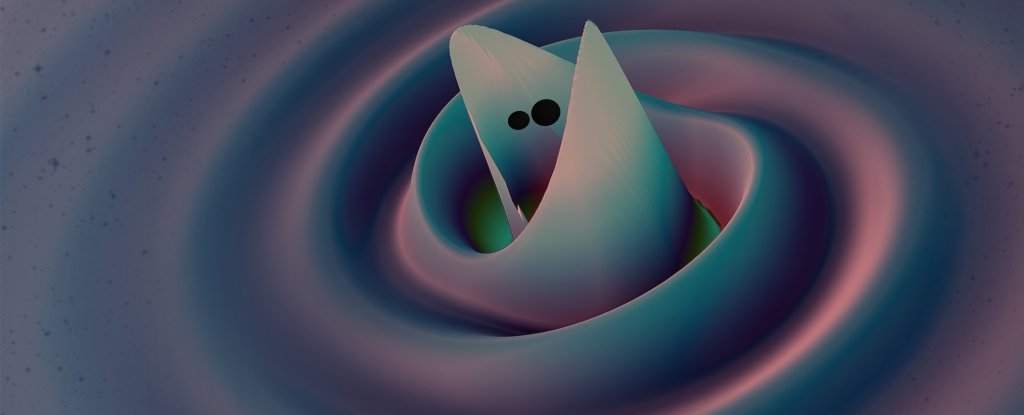Products You May Like
From 7 billion light-years away, a pair of colliding black holes has delivered up, on a shiny gravitational wave platter, one of the most sought-after detections in black hole astronomy – the extremely elusive ‘middleweight’ black hole, which lies in between stellar-mass black holes and supermassive behemoths.
Not only, however, did the two colliding black holes combine to form this intermediate-mass black hole, but one of them was another black hole unicorn – falling squarely in what’s called the ‘upper mass gap’, in between stellar-mass black holes and intermediates, where no black holes have ever been detected in the Milky Way.
“This event opens more questions than it provides answers,” said LIGO member and physicist Alan Weinstein of Caltech. “From the perspective of discovery and physics, it’s a very exciting thing.”
The gravitational wave signal from the collision, detected by the LIGO and Virgo interferometers on 21 May 2019, was extremely short compared to previous collision detections.
But hard work analysing it revealed that the product of the merger was a black hole around 142 times the mass of the Sun, and that the two objects that created it were 66 and 85 solar masses. That’s more massive than any black hole collision we’ve detected in the five years since we first detected gravitational waves.
[embedded content]
“Right from the beginning this signal, which is only a tenth of a second long, challenged us in identifying its origin,” said theoretical physicist Alessandra Buonanno of the Max Planck Institute for Gravitational Physics in Germany and the University of Maryland.
“But, despite its very short duration, we were able to match the signal to one expected of black-hole mergers, as predicted by Einstein’s theory of general relativity, and we realised we had witnessed, for the first time, the birth of an intermediate-mass black hole from a black-hole parent that most probably was born from an earlier binary merger.”
Not only do these results shed new light on intermediate-mass and upper mass-gap black holes, they are a key to understanding another black hole mystery – how supermassive beasts get so, well, supermassive.
Black holes are a mystery at the best of times. Since they don’t emit or reflect any radiation we can detect, we usually don’t even know they’re there, unless they’re actively devouring material – a process that emits a great deal of radiation from just outside the black hole.

Simulation showing gravitational waves rippling out from the pre-merger inspiral. (Deborah Ferguson, Karan Jani, Deirdre Shoemaker, Pablo Laguna, Georgia Tech, MAYA Collaboration)
But intermediate mass black holes? They’re just a mystery on a mystery – because there don’t seem to be a lot of them out there. We’ve detected stellar-mass black holes, up to 100 times the mass of the Sun; and we’ve detected supermassive black holes, typically between a million and a billion times more massive than stellar-mass black holes.
Astronomers have made detections that they think are very likely intermediate-mass black holes, but – as with most black hole detections – they’re indirect, and therefore remain inconclusive.
But gravitational waves allow us to detect black hole binaries – and the products of their mergers – directly. Which makes the newly discovered signal, GW 190521, the first conclusive direct observation of an intermediate mass black hole.
“One of the great mysteries in astrophysics is how do supermassive black holes form?” said gravitational-wave astronomer Christopher Berry of Northwestern University.
“They are the million solar-mass elephants in the room. Do they grow from stellar-mass black holes, which are born when a star collapses, or are they born via an undiscovered means? Long have we searched for an intermediate-mass black hole to bridge the gap between stellar-mass and supermassive black holes. Now, we have proof that intermediate-mass black holes do exist.”
[embedded content]
But that 85-solar-mass black hole is also a wonder. Because, according to our models, black holes over about 65 solar masses can’t form from a single star, like stellar mass black holes.
That’s because the precursor stars are so massive that their supernovae – known as pair-instability supernovae – ought to completely obliterate the stellar core, leaving nothing behind to gravitationally collapse into a black hole.
This creates what we call the ‘upper mass gap’ (the lower mass gap is between black holes and neutron stars; you can read about that here if you like). GW 190521’s 85-solar-mass black hole is the first black hole confidently detected in this mass gap.
It presents another puzzle. Detecting a black hole squarely in this mass gap could mean that we don’t understand massive supernovae as well as we thought; or, perhaps more likely, that the 85-solar-mass black hole was the result of an earlier merger.
Of course, it’s impossible to tell at this stage – when gravitational wave astronomy is still only in its infancy – whether the event itself was an outlier.
“We don’t know yet whether GW190521, this surprising discovery and first observation of an intermediate mass black hole, is an entirely new class of binary black holes or just the high-mass end of the source spectrum we’ve seen so far,” said physicist Karsten Danzmann of the Albert Einstein Institute Hannover and the Institute for Gravitational Physics at Leibniz University Hannover in Germany.
Making these direct detections for the very first time is tremendously exciting, and represents the very best of a scientific discovery: answering questions, and going on to pose a whole plethora of new ones.
“We’re really in the dawn of gravitational-wave astronomy,” said astronomer Chase Kimball of Northwestern University. “It’s hard to pick a better time to come up as an astrophysicist.”
The research has been published in Physical Review Letters and The Astrophysical Journal Letters.
